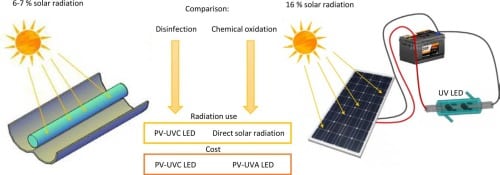
Journal of Environmental Chemical Engineering, Volume 11, Issue 2, April 2023, 109332
Miguel Martín-Sómer, María Dolores Molina-Ramírez, Maria Luisa Perez-Araujo, Rafael van Grieken, Javier Marugán
This work analyses how to optimise efficiency in the use of solar light for different UV-based photochemical water treatment processes. The direct use of sunlight in state-of-the-art compound parabolic collector (CPC) photoreactors is compared with the use of solar energy for electricity generation in photovoltaic (PV) power systems to feed LED lighting sources. Seven different solar processes (CPC, PV-UVA LED, PV-UVC LED, CPC+TiO2, CPC+H2O2, PV-UVA LED+TiO2 and PV–UVC LED+H2O2) were investigated, both for the oxidation of chemicals and the inactivation of bacteria. The results showed that, for the oxidation of chemicals, the best photochemical yield (in terms of the use of photons) is achieved by the PV-UVC LED+H2O2 process. However, the low electrical efficiency of current UVC LED sources makes the CPC+TiO2 process the most efficient in the use of solar light. In contrast, for bacterial inactivation, the significantly higher effectiveness of the UVC spectral range in damaging DNA makes the PV-UVC LED+H2O2 the most efficient in the use of sunlight. When costs are considered, the PV-UVA LED+TiO2 may be the most efficient process for chemical oxidation, while the PV-UVC LED+H2O2 process could be the most efficient for bacterial inactivation. These findings highlight the need to evaluate the optimal approach in reactor engineering for applications in the water-energy nexus, since the most efficient process for the use of solar light strongly depends on the electrical efficiency of the available PV and LED technology, which can be expected to be largely improved in the near future.
…Relative spectral power of UVC and UVA LED measured by an StellarNet UVIS-25 spectrometer, standard AM 1.5 solar spectrum [32] and relative spectral absorption of TiO2 and H2O2 …





